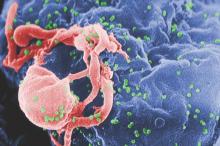Patients infected with HIV-1 subtype C failed antiretroviral therapy significantly earlier than did HIV-1B–infected patients, especially when they received ritonavir-boosted protease inhibitors instead of nonnucleoside reverse transcriptase inhibitors, according to a Swedish national cohort study.
“As low- and middle-income countries are poised to scale up second-line antiretroviral therapy containing ritonavir-boosted PIs [protease inhibitors], a concern is that PIs will be less efficient in patients with HIV-1C,” said Dr. Ujjwal Neogi of the Karolinska Institute in Stockholm and his associates. “Studies of new drugs such as integrase inhibitors should be done in patients with HIV-1C and other non-B subtypes, which are responsible for the greatest global HIV burden,” they wrote online in the Lancet HIV.
HIV-infected patients in low-income and middle-income countries often receive second-line boosted PI-based regimens, but few studies have rigorously looked at treatment response for the HIV-1C subtype, which causes most infections in countries such as Ethiopia, India, and South Africa, the investigators noted. They studied more than 99% of Sweden’s HIV-positive population to identify predictors of virologic failure. The dataset included 1,077 HIV-1B–infected patients and 596 HIV-1C–infected patients; 90% of the latter were immigrants (Lancet HIV. 2016 Mar 14. doi: 10.1016/S2352-3018[16]00023-0).
Predictors of primary virologic failure included higher baseline viral load (odds ratio, 1.8; 95% confidence interval, 1.5-2.2); subtype C infection (OR, 1.75; 1.1-2.9), and boosted PI-based regimens (OR, 1.55; 95% CI, 1.5-2.1). After adjustment for transmission route and duration of antiretroviral therapy, time to secondary virologic failure on boosted PI-based regimens was significantly earlier for HIV-1C–infected patients, compared with HIV-1B patients (hazard ratio, 1.8; 95% CI, 1.3-2.9). However, HIV-1 subtype did not significantly predict time to virologic failure for nonnucleoside reverse transcriptase inhibitor–based regimens.
“The poorer treatment outcome occurred in the patients with HIV-1C despite developed clinical care, modern laboratory monitoring, and focused adherence support at highly HIV-specialized infectious disease clinics in a high-income country,” the researchers wrote. Self-reported adherence to therapy did not differ by treatment regimen or HIV-1 subtype, although adherence data were available for only about a third of HIV-1C–infected patients, they added.
Homology-based molecular modeling also seemed to show a lower affinity between the PIs darunavir and lopinavir and the HIV-1C protease, compared with the HIV-1B protease, said the researchers. “Naturally occurring polymorphisms in HIV-1C protease might affect the binding of at least some protease inhibitors, potentially contributing to the differences we observed,” they concluded.
The study was funded by the Karolinska Institutet Research Foundation, Swedish Research Council, Stockholm County Council, Swedish Physicians against AIDS, National Institutes of Health, and University of Missouri. The investigators had no relevant financial disclosures.


